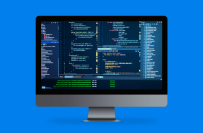
Sound Source Position algorithm
€30-250 EUR
Complété
Publié il y a presque 5 ans
€30-250 EUR
Payé lors de la livraison
I need a algorithm for sound-position calculation with three to five microphones in line.
Microphone spacing is equal with a total length of 300-1000mm
The known factors is:
-time difference (down to micros with upto four decimals) between sound hitting the first microphone and hitting the others. (aka. timestamps)
-the physical position of microphones.(x,y)
The postion of the sound-source must then be given with a X-Y coordinate calculated to a grid with variable size. (x1000,y1000)
The algorith must also come with an explanation of the variables and functions
Variables to be accounted for:
Speed of sound in air (temperature offset wil bee handled externally)
Number of Mics.
Distance between mics
Size/scale of grid the results are plotted in.
Preferably in Python but could also be in plain paper math
See attached .jpg for an idea of the imagined setup
N° de projet : 24078169
Concernant le projet
11 propositions
Projet à distance
Actif à il y a 5 ans
Cherchez-vous à gagner de l'argent ?
Avantages de faire une offre sur Freelancer
Fixez votre budget et vos délais
Soyez payé pour votre travail
Surlignez votre proposition
Il est gratuit de s'inscrire et de faire des offres sur des travaux
11 freelances proposent en moyenne €150 EUR pour ce travail

4,9
(39 commentaires)
5,7
5,7

4,9
(10 commentaires)
5,0
5,0

4,6
(19 commentaires)
4,9
4,9

5,0
(4 commentaires)
3,6
3,6

5,0
(8 commentaires)
3,8
3,8

5,0
(7 commentaires)
3,5
3,5

5,0
(2 commentaires)
0,4
0,4
À propos du client

skien, Norway
5,0
2
Méthode de paiement vérifiée
Membre depuis avr. 11, 2015
Vérification du client
Travaux similaires
₹1500-12500 INR
$3-6 USD / heure
$30-250 USD
$30-250 USD
$30-250 USD
$10-30 USD
$1500-3000 USD
€30-250 EUR
₹600-1500 INR
₹1500-12500 INR
₹100-400 INR / heure
₹75000-150000 INR
$2-8 AUD / heure
₹750-1250 INR / heure
₹750-1250 INR / heure
$250-750 USD
€8-30 EUR
$8-15 AUD / heure
$100-150 USD
$250-750 USD
Merci ! Nous vous avons envoyé un lien par e-mail afin de réclamer votre crédit gratuit.
Une erreur a eu lieu lors de l'envoi de votre e-mail. Veuillez réessayer.
Chargement de l'aperçu
Permission donnée pour la géolocalisation.
Votre session de connexion a expiré et vous avez été déconnecté. Veuillez vous connecter à nouveau.

























